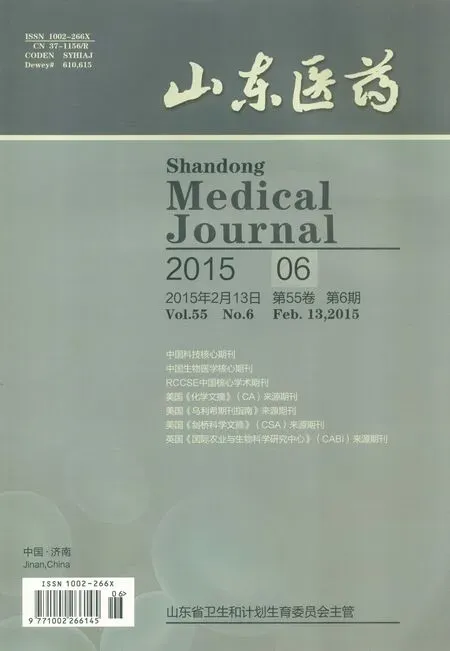有大肠癌家族史的大肠多发性腺瘤患者瘤组织中APC、Survivin蛋白的表达及意义
赵婧,荆洋,吕宗舜,周璐
(天津医科大学总医院,天津 300052)
有大肠癌家族史的大肠多发性腺瘤患者瘤组织中APC、Survivin蛋白的表达及意义
赵婧,荆洋,吕宗舜,周璐
(天津医科大学总医院,天津 300052)
目的 观察有大肠癌家族史的大肠多发性腺瘤组织中中抑癌基因APC和凋亡抑制基因Survivin的表达变化,并探讨其意义。方法 采用免疫组织化学方法检测20例大肠腺癌、32例有大肠癌家族史的大肠多发性腺瘤、32例无大肠癌家族史的大肠多发性腺瘤、20例正常大肠组织中APC及Survivin蛋白的表达情况。结果 在大肠腺癌、有大肠癌家族史的大肠多发性腺瘤、无大肠癌家族史的大肠多发性腺瘤和正常组织中APC蛋白的阳性表达率分别为20.0%、56.3%、65.6% 和95.0%。Survivin蛋白的阳性表达率分别为 75.0%、40.6%、28.1%和0。有大肠癌家族史的大肠多发性腺瘤组APC蛋白阳性表达强度低于无家族史的大肠多发性腺瘤组,Survivin蛋白阳性强度高于无家族史的大肠多发性腺瘤组(P均<0.05)。结论 与正常大肠组织相比,大肠多发性腺瘤组织中APC蛋白表达下调,Survivin蛋白表达上调;与无大肠癌家族者相比,有大肠癌家族史的大肠多发性腺瘤组织中APC蛋白表达更低,Survivin蛋白表达更高。
大肠癌;家族史;大肠腺瘤;腺瘤性息肉病蛋白;生存素
流行病学研究发现有大肠癌家族史的人群中大肠腺瘤的恶变风险高于普通人群,但这些腺瘤组织中分子生物学的改变是否不同于普通人群仍待研究[1, 2]。腺瘤性息肉病(APC)基因是一种抑癌基因,其突变会引起大肠肿瘤的发生,在腺瘤向腺癌进展的过程中,表达逐渐减低[3]。生存素(Survivin)基因是一种凋亡抑制基因,表达于肿瘤组织中,并且随着肿瘤的发展,其表达逐渐增强。这两种基因可以作为大肠腺瘤恶变风险评估的生物学标志[3, 4]。2009年6月~2013年12月,我们检测了大肠腺癌、有大肠癌家族史的大肠多发性腺瘤、无大肠癌家族史的大肠多发性腺瘤及正常组织中APC及Survivin蛋白的表达情况,并探讨其临床意义。现报告如下。
1 资料与方法
1.1 临床资料 收集2009年6月~2013年12月于我院肠镜下活检并由病理科存档的大肠组织标本,其中大肠腺癌20例(A组),有大肠癌家族史的大肠多发性腺瘤32例(B组),无大肠癌家族史的大肠多发性腺瘤32例(C组)及正常结肠黏膜20例(D组)。4组患者性别年龄差异无统计学意义。所有病例均经病理确诊并有完整的随访资料(包括一般情况、个人疾病史、家族史)。纳入标准:①所有大肠多发性息肉至少取两处组织并经病理证实均为腺瘤,取腺瘤较大者纳入;②所有病例均无家族性腺瘤性息肉病史、遗传性非息肉病性大肠癌史、克罗恩病及溃疡性结肠炎病史;③B、C、D组患者本人无恶性肿瘤病史;④B、C组患者均为首次发现大肠腺瘤;⑤所有患者检查前均未接受放疗、化疗及免疫治疗。B组中管状腺瘤19例,管状绒毛状腺瘤9例,绒毛状腺瘤4例;轻、中度非典型增生28例,重度非典型增生4例;腺瘤最大径<1 cm者25例, ≥1 cm者7例;息肉数量<5个19例,≥5个13例。C组中管状腺瘤20例,管状绒毛状腺瘤8例,绒毛状腺瘤4例;轻、中度非典型增生28例,重度非典型增生4例;腺瘤最大径<1 cm者26例, ≥1 cm者6例;息肉数量<5个22例,≥5个10例。B、C组病理类型、腺瘤大小、息肉数目差异无统计学意义。
1.2 APC和Survivin表达检测及结果判定方法 采用免疫组织化学染色法。标本经4%甲醛固定,常规石蜡包埋,4 μm厚连续切片,常规脱蜡至水,柠檬酸缓冲液微波抗原修复,用0.3%双氧水(H2O2)37 ℃孵育10 min,每例样本分为两份,其中1份滴加兔抗人APC单克隆抗体,另1份滴加兔抗人Survivin单克隆抗体。4 ℃冰箱孵育过夜,滴加通用型IgG抗体(二抗)于37 ℃温箱孵育45 min,二氨基联苯胺(DAB)显色,自来水清洗,苏木素复染细胞核,脱水,中性树胶封片。用已知阳性片做阳性对照,以磷酸盐缓冲液(PBS)代替一抗做阴性对照。
APC主要定位于细胞质,以胞质内出现棕黄色颗粒为阳性细胞;Survivin主要定位于细胞核,以胞核出现棕黄色颗粒为阳性细胞。每张切片由两位观察者双盲交换判断,随机选取5个高倍视野(×400),计数500个细胞。参照Kawasaki等[5]的标准根据阳性细胞百分比和染色着色强度进行综合评分。①根据阳性细胞百分比进行评分:阳性细胞<5%为0分,5%~25%为1分,26%~50%为2分,51%~75%为3分,>75%为4分。②根据细胞着色强度进行计分:不着色为0分,浅棕黄色为1分,棕黄色为2分,棕褐色为3分。两项评分相乘即为该标本阳性表达强度:0分为阴性-,1~4分为弱阳性(+),5~8分为阳性(++),9~12分为强阳性(+++)。弱阳性、阳性、强阳性均视为标本阳性表达。阳性表达率=阳性表达标本数/入组标本数×100%。
1.3 统计学方法 采用SPSS17.0统计软件。组间比较采用χ2检验和Fisher确切概率法。P<0.05为差异有统计学意义。
2 结果
2.1 APC和Survivin阳性表达率 A、B、C、D组APC阳性表达率分别为20.0%、56.3%、65.6%和95.0%。APC蛋白阳性表达率B、C组高于A组,低于D组(P均<0.05);B、C组APC阳性表达率相比差异无统计学意义。A、B、C、D组Survivin阳性表达率分别为75.0%、40.6%、28.1%和0。Surrivin蛋白阳性表达率B、C组低于A组,高于D组(P均<0.05);B、C组相比差异无统计学意义。
2.2 APC和Survivin表达强度 B组APC表达+者10例、++者6例、+++者2例,C组分别为2、9、10例,B、C组APC蛋白阳性表达强度相比P<0.05。B组多为+,C组多为++和+++,B组APC蛋白阳性表达强度低于C组。B组Survivin表达+者3例、++者10例、+++者0例,C组分别为7、2、0例,B、C组Survivin蛋白阳性表达强度相比P<0.05。B组多为++,C组多为+,B组Survivin蛋白阳性表达强度高于C组。
3 讨论
大肠癌家族史是大肠癌发生的高危因素,有大肠癌家族史的人群患大肠癌的风险是无大肠癌家族史人群的2~4倍[6]。有研究发现,在有大肠癌家族史的人群中,大肠腺瘤的发病率以及腺瘤癌变的风险也高于普通人群[1, 2, 7]。在探究其具体机制的研究中,Hao等[8]发现在有大肠癌家族史的人群中,肉眼观察正常的结肠黏膜也有多种基因表达异常,并且这种分子学异常改变先于腺瘤性息肉的发生,这些改变可能是有大肠癌家族史人群大肠腺瘤发生率高的原因之一。
APC基因是一种抑癌基因,是Wnt信号转导途径的调控因子。APC基因突变时,Wnt信号通路持续激活,导致β-catenin降解减少,积聚于细胞质及细胞核中,与转录因子TCF/ LEF结合形成复合体,激活靶基因的转录,促使肿瘤发生[9, 10]。Survivin是细胞凋亡抑制蛋白(IAP)家族的一个新成员,具有调节细胞有丝分裂和抑制凋亡的双重功能。Survivin基因过表达失去抑制细胞凋亡的功能,细胞增殖和分化的平衡被破坏,促使肿瘤发生[11]。国内外研究发现APC在正常结肠黏膜、腺瘤及腺癌中的阳性表达率依次降低[10, 12],与本研究结果一致。APC基因突变发生于腺瘤癌变的早期,在散发性大肠癌形成的过程中是腺瘤恶化的必要条件[10, 12]。Jonathan等[13]研究发现,Survivin过表达在大肠癌的形成中是一个早期事件,在组织恶变过程中表达逐渐增高,与本研究结果一致。相霞等[12]发现Survivin在组织中的表达强度是个渐进的过程,在正常大肠组织—腺瘤—腺癌病变进展过程中,其阳性表达逐渐增高。APC及Survivin基因表达异常在一定程度上反映了大肠肿瘤的进展程度,可以作为大肠腺瘤恶变风险评估的生物学标志[3, 4, 12]。
在有大肠癌家族史的人群中大肠腺瘤及大肠癌的发病率均高于无家族史人群[1],大肠癌多为大肠腺瘤恶变发展而来,腺瘤的癌变需要较长的时间,而腺瘤组织中某些基因学的改变发生于腺瘤癌变的早期[10],可对腺瘤癌变起到一定的预示作用。本研究发现有大肠癌家族史的大肠多发性腺瘤组APC蛋白的阳性强度低于无家族史组,Survivin蛋白阳性强度高于无家族史组,说明有大肠癌家族史的大肠多发性腺瘤的基因表达异常程度高于无家族史组,从分子生物学上说明前者有更高癌变的风险。因此,对此类高危人群合理规划大肠癌筛查方案具有重要意义。美国胃肠病学会2008年结直肠癌筛查指南建议:普通人群从50岁开始,每10年进行一次结肠镜检查;一级亲属有大肠癌病史人群从40岁开始每5年进行一次结肠镜检查,或者比患大肠癌的一级亲属诊断时年龄提前10年开始,每5年进行一次结肠镜检查[14]。然而,Bujanda等[15]对大肠癌患者的一级亲属行结肠镜筛查的依从性进行了多中心的前瞻性研究,结果发现其依从率仅有38%。其原因可能是对这类人群高风险性评估的理论证据不足。因此需要更多的证据证实有大肠癌家族史人群患大肠癌风险高于普通人群。本研究发现APC及Survivin在有大肠癌家族史的大肠多发性腺瘤中的表达异常程度高于无家族史者,为有大肠癌家族史人群进行结肠镜筛查提供了新的依据,有助于提高有大肠癌家族史人群筛查结肠镜的依从性,以早发现大肠腺瘤并予以切除,减少大肠癌的患病率及病死率,降低因大肠癌引起的诊断及治疗费用[16]。
[1] Wilschut JA, Habbema JD, Ramsey SD, et al. Increased risk of adenomas in individuals with a family history of colorectal cancer: results of a meta-analysis[J]. Cancer Causes Control, 2010,21(12):2287-2293.
[2] Del VBG, Cretella M, Paoluzi OA, et al. Adenoma, advanced adenoma and colorectal cancer prevalence in asymptomatic 40- to 49-year-old subjects with a first-degree family history of colorectal cancer[J]. Colorectal Dis, 2013,15(9):1093-1099.
[3] Ahearn TU, Shaukat A, Flanders WD, et al. Markers of the APC/beta-catenin signaling pathway as potential treatable, preneoplastic biomarkers of risk for colorectal neoplasms[J]. Cancer Epidemiol Biomarkers Prev, 2012,21(6):969-979.
[4] Lin LJ, Zheng CQ, Jin Y, et al. Expression of survivin protein in human colorectal carcinogenesis[J]. World J Gastroenterol, 2003,9(5):974-977.
[5] Kawasaki H, Altieri DC, Lu CD, et al. Inhibition of apoptosis by survivin predicts shorter survival rates in colorectal cancer[J]. Cancer Res, 1998,58(22):5071-5074.
[6] Ait OD, Lockett T, Boussioutas A, et al. Screening participation for people at increased risk of colorectal cancer due to family history: a systematic review and meta-analysis[J]. Fam Cancer, 2013,12(3):459-472.
[7] Jong AE, Vasen HF. The frequency of a positive family history for colorectal cancer: a population-based study in the Netherlands[J]. Neth J Med, 2006,64(10):367-370.
[8] Hao CY, Moore DH, Wong P, et al. Alteration of gene expression in macroscopically normal colonic mucosa from individuals with a family history of sporadic colon cancer[J]. Clin Cancer Res, 2005,11(4):1400-1407.
[9] Schneikert J, Behrens J. The canonical Wnt signalling pathway and its APC partner in colon cancer development[J]. Gut,2007,56(3):417-425.
[10] Iwamoto M, Ahnen DJ, Franklin WA, et al. Expression of beta-catenin and full-length APC protein in normal and neoplastic colonic tissues[J]. Carcinogenesis, 2000,21(11):1935-1940.
[11] Kalliakmanis JG, Kouvidou C, Latoufis C, et al. Survivin expression in colorectal carcinomas: correlations with clinicopathological parameters and survival[J]. Dig Dis Sci, 2010,55(10):2958-2964.
[12] 相霞,韦统友,马江伟,等. Survivin、Smad4/dpc4、APC基因在大肠腺瘤和腺癌中的表达及意义[J]. 中国医师杂志,2010,12(5):625-628.
[13] Hernandez JM, Farma JM, Coppola D, et al. Expression of the antiapoptotic protein survivin in colon cancer[J]. Clin Colorectal Cancer, 2011,10(3):188-193.
[14] Rex DK, Johnson DA, Anderson JC, et al. American College of Gastroenterology guidelines for colorectal cancer screening 2009[J]. Am J Gastroenterol, 2009,104(3):739-750.
[15] Bujanda L, Sarasqueta C, Zubiaurre L, et al. Low adherence to colonoscopy in the screening of first-degree relatives of patients with colorectal cancer[J]. Gut, 2007,56(12):1714-1718.
[16] Lin OS. Colorectal cancer screening in patients at moderately increased risk due to family history[J]. World J Gastrointest Oncol, 2012,4(6):125-130.
Expressions and significances of APC and Survivin protein in colorectal multiple adenomas with a family history of colorectal cancer
ZHAOJing,JINGYang,LVZong-shun,ZHOULu
(GeneralHospitalofTianjinMedicalUniversity,Tianjin300052,China)
Objective To investigate the expressions and significances of tumor suppressor gene APC and apoptosis inhibiting gene Survivin in colorectal multiple adenomas with a family history of colorectal cancer. Methods The expressions of APC and Survivin gene were detected by immunohistochemical staining among the cases from 20 colorectal adenocarcinomas, 32 colorectal multiple adenomas with a family history of colorectal cancer, 32 colorectal multiple adenomas without a family history of colorectal cancer, 20 normal colorectal mucosas. Results There had differences in positive rate for expressions of APC and Survivin among the colorectal adenocarcinomas, the colorectal multiple adenomas with a family history of colorectal cancer, the colorectal multiple adenomas without a family history of colorectal cancer, the normal colorectal mucosas, the positive rate of APC protein was 20.0%, 56.3%, 65.6%, 95.0%, respectively (P<0.01). The positive rate of Survivin protein was 75.0%, 40.6%, 28.1%, 0%, respectively (P<0.01). In colorectal multiple adenomas with a family history of colorectal cancer, the positive intensity of APC protein was lower and the positive intensity of Survivin protein was higher than that in the colorectal multiple adenomas without a family history of colorectal cancer (allP<0.05). Conclusion Compared with the normal colorectal mucosas, the APC protein down-regulated expression and Survivin protein up-regulated expression in colorectal multiple adenomas. In colorectal multiple adenomas with a family history of colorectal cancer, the expression of APC protein was lower and the expression of Survivin protein was higher than that in the colorectal multiple adenomas without a family history of colorectal cancer.
colorectal cancer; family history; colorectal adenoma; adenomatous polyposis coli; Survivin
天津市自然科学基金资助项目(20120513)。
赵婧(1987-),女,硕士,主要研究方向为消化系统疾病,邮箱:zhaojing200808@163.com
吕宗舜(1956-),男,硕士生导师,主任医师,主要研究方向为消化系统疾病,邮箱:lzs_zyy@163.com
10.3969/j.issn.1002-266X.2015.06.008
R735.3
A
1002-266X(2015)06-0024-04
2014-08-13)

